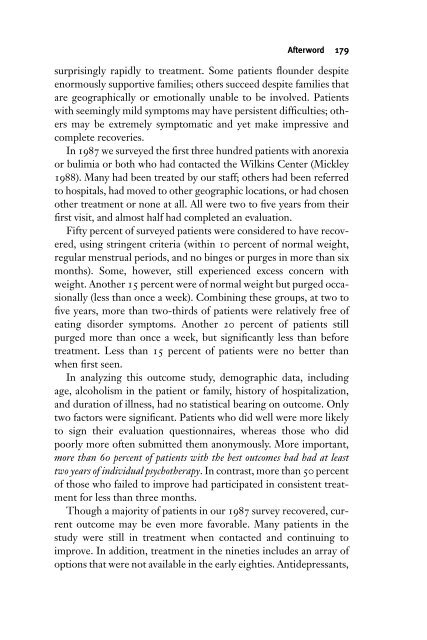Eating Disorders - fieldi
Eating Disorders - fieldi
Eating Disorders - fieldi
You also want an ePaper? Increase the reach of your titles
YUMPU automatically turns print PDFs into web optimized ePapers that Google loves.
Afterword 179<br />
surprisingly rapidly to treatment. Some patients flounder despite<br />
enormously supportive families; others succeed despite families that<br />
are geographically or emotionally unable to be involved. Patients<br />
with seemingly mild symptoms may have persistent difficulties; others<br />
may be extremely symptomatic and yet make impressive and<br />
complete recoveries.<br />
In 1987 we surveyed the first three hundred patients with anorexia<br />
or bulimia or both who had contacted the Wilkins Center (Mickley<br />
1988). Many had been treated by our staff; others had been referred<br />
to hospitals, had moved to other geographic locations, or had chosen<br />
other treatment or none at all. All were two to five years from their<br />
first visit, and almost half had completed an evaluation.<br />
Fifty percent of surveyed patients were considered to have recovered,<br />
using stringent criteria (within 10 percent of normal weight,<br />
regular menstrual periods, and no binges or purges in more than six<br />
months). Some, however, still experienced excess concern with<br />
weight. Another 15 percent were of normal weight but purged occasionally<br />
(less than once a week). Combining these groups, at two to<br />
five years, more than two-thirds of patients were relatively free of<br />
eating disorder symptoms. Another 20 percent of patients still<br />
purged more than once a week, but significantly less than before<br />
treatment. Less than 15 percent of patients were no better than<br />
when first seen.<br />
In analyzing this outcome study, demographic data, including<br />
age, alcoholism in the patient or family, history of hospitalization,<br />
and duration of illness, had no statistical bearing on outcome. Only<br />
two factors were significant. Patients who did well were more likely<br />
to sign their evaluation questionnaires, whereas those who did<br />
poorly more often submitted them anonymously. More important,<br />
more than 60 percent of patients with the best outcomes had had at least<br />
two years of individual psychotherapy. In contrast, more than 50 percent<br />
of those who failed to improve had participated in consistent treatment<br />
for less than three months.<br />
Though a majority of patients in our 1987 survey recovered, current<br />
outcome may be even more favorable. Many patients in the<br />
study were still in treatment when contacted and continuing to<br />
improve. In addition, treatment in the nineties includes an array of<br />
options that were not available in the early eighties. Antidepressants,









